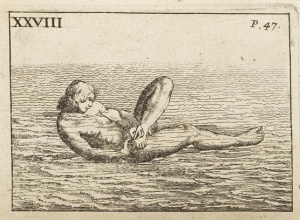How-to Books for Everyday Living
Elizabeth Walsh, Head of Reader Services, and Rosalind Larry, Head of Circulation, curated How-to Books for Everyday Living for The Curatorial Eye: Discoveries from the Folger Vault, part of the Exhibitions at the Folger.
Beginning in the sixteenth century and continuing throughout the seventeenth century, procedural manuals, or how-to books, were very popular, not only with the English gentry, but with the average person as well. The manuals are generally small in size and contain legible type, clearly defined illustrations, and tables of contents calculated to help the reader carry out a variety of tasks with ease. The Folger Shakespeare Library has a rich collection of early modern how-to books covering topics such as cooking, reading, writing, singing, drawing, swimming, budgeting, and estate management, to name but a few.

In the seventeenth century, swimming was viewed not so much as a recreational pastime but more as an exercise in self-discipline and a mechanical art through which men could build and manage body strength. Thévenot’s illustrations highlight certain physical activities, such as cutting the toenails, pictured to the left, which are allegedly easier to accomplish in the water than on dry land. This popular how-to manual enjoyed wide circulation; even Benjamin Franklin owned a copy.
Another manual provides a collection of pastry and egg recipes, translated from the French. This book has a more practical use in a prosperous household with a professional chef (the common housewife would not likely be following recipes such as these). In addition to the different pastry recipes, the author includes fifty-five ways to dress eggs.
Thomas Jenner's A book of drawing, limning, washing or coloring maps and prints… is another manual for the gentry. This treatise provides very useful instructions on the various types of instruments, inks, metals, and surfaces necessary for the art of drawing. It also provides instructions on how to draw animals, landscapes, and objects. The linked call number shows a very detailed engraving from this manual of how to diagram the human face (141-730f).
John Hart's volume instructed non-professionals to teach others how to read. His method was based on a phonetic alphabet he devised. The linked call number shows symbols that Hart created to represent the sounds of common vowel and consonant combinations can be seen in this image of the Lord’s Prayer, a popular reading exercise for beginners (STC 12889).
Finally, a small volume on budget management rounds out this group of how-to manuals. By living frugally “I am made superior to the Frowns of Fortune,” states Thomas Tryon in the preface to his handy little pocket volume. Tryon recommends a diet based on bread, vegetables, and water as both healthy and economical. The linked call number shows that, in addition to recipes, the book is filled with cost-saving suggestions (150-428q). For example, ale which has gone flat can be boiled and used to remove stains from your hat.
Head of Reader Services, Betsy Walsh gives additional instruction on activities that are more easily done in water.
Walsh also discusses Thomas Tryon's advice on living simply.